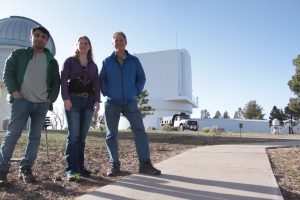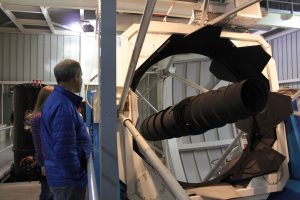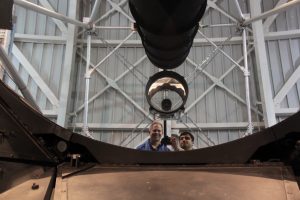Over the course of four nights in April and May, the RECON team was able to use Apache Point Observatory’s Astrophysical Research Consortium Telescope Imaging Camera (ARCTIC) on the 3.5-meter ARC telescope to more accurately determine the positions of 31 trans-Neptunian Objects (TNOs). The objects that were observed had high uncertainties in their known orbits that limited our ability to predict occultations. By taking three separate exposures spread out over multiple hours, each object can be seen moving across the sky relative to the stars. By then measuring the object’s position as it moves through the night, a more accurate orbit for the object can be defined, resulting in more accurate occultation predictions. This is an important step in the occultation prediction process. The goal of these measurements is to identify the occultation events with a nominal 30% probability of success.
Drs. Rodrigo Leiva (RECON Postdoctoral Researcher) and John Keller (RECON Co-PI) observed at Apache Point Observatory on April 16-18, 2018. During the first night, they were trained on the APO 3.5-meter telescope by New Mexico State University astronomer Dr. Candace Gray. They then collected astrometry data for 14 out of 21 during the morning hours of the subsequent two nights.
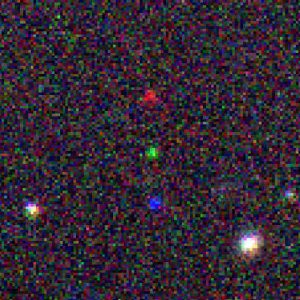
Mosaic of three Gemini images showing position of moving TNO (red, blue, and green dots)
For May 18th and 19th, Rodrigo remotely observed from Boulder with help from new RECON student research assistants Sean Haley, Lizzie Wilde, and Ryder Strauss while John was in Washington DC remotely controlling the telescope. After taking flats, darks, and bias frames, science images started to roll in. The objects observed were between magnitude 20-23 and were observed 3 times over the course of both nights. Each exposure of the same object was taken long enough apart so that the object had moved at least three arcseconds across the sky from the previous exposure. Sean, Lizzie, and Ryder looked through all the science images as they came in to make sure they were good to use (no weird light artifacts) and to confirm that the object was in the frame. Each object was found by assigning a pixel color (red, green, and blue) to the three images taken of each object and combined to make a color image that is useful to find moving targets – can you guess why? An example of what is seen with this method is shown below. 17 out of 18 objects were successfully recovered and put into the RECON occultation prediction system.
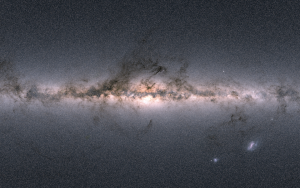
The GAIA DR2 data that measures the positions and velocities of billions of stars in the Milky Way galaxy.
The occultation prediction system has also now been updated with the new, much more accurate, Gaia DR2 (Data Release 2) data, shown here. With an incredible increase in positional accuracy (three orders of magnitude more accurate than previously measured!) provided by Gaia, the uncertainty of star locations is no longer a significant factor in our occultation predictions. This means there are more accurate occultation predictions than ever before, which is great news for the future of RECON! Overall, 31 TNO positions were improved to bring the uncertainty in their orbits down to ~0.1 arcseconds. All of these objects are now updated in the system with the new more accurate orbit information gained in these observing runs. They are now accurate enough to potentially provide us with some great occultation opportunities in the future.

